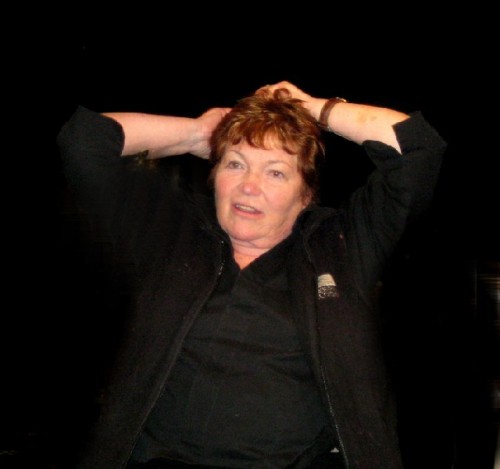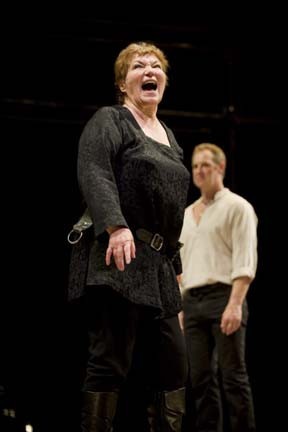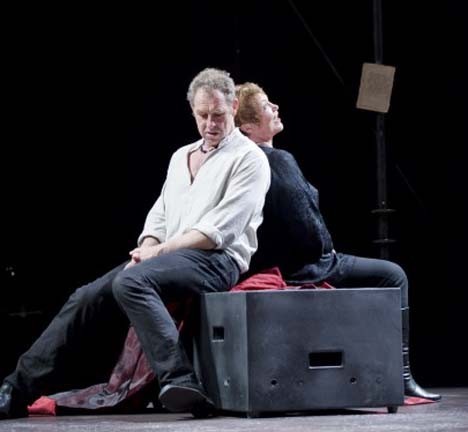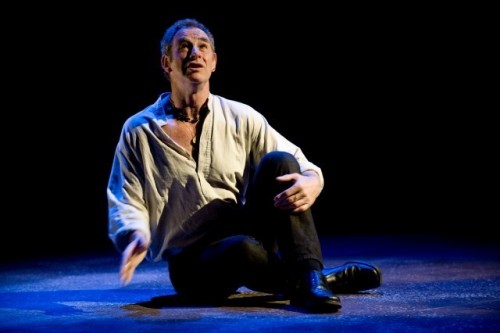Tina Packer in Women of Will to July 10
Tina Packer Launches S&Co Season in Lenox
By: Bard - May 12, 2011
Shakespeare & Company presents Women of Will, The Complete Journey: Parts I-V, the masterful summation of Founding Artistic Director Tina Packer ’s 40-odd years spent investigating all things Shakespeare, presented in a five-part series. A combination of riveting scenes and lively, fascinating analysis, Women of Will, The Complete Journey explores themes of love, loss, freedom, control, and violence and power through the heroines of Shakespeare’s text.
This newly finished version of Women of Will is fully expanded and presented in five parts, giving those who saw Packer’s Women of Will Overview last summer a complete look into Packer’s stunning examination of Shakespeare's words and world. In The Complete Journey, Packer once again uses performance and discussion, as she traces the chronological evolution of Shakespeare’s female characters, and examines Shakespeare’s own journey as a writer
Director Eric Tucker returns to join forces with Packer and her talented acting mate Nigel Gore, giving the trio another opportunity to tackle Shakespeare’s canon. Packer and Gore have starred opposite each other in several productions, including Who’s Afraid of Virginia Woolf (which netted Gore an Elliot Norton Award for Best Actor in 2010), Antony & Cleopatra, Hamlet, and Coriolanus (Packer’s all-male version in England last year) to name a few.
All three artists have been working together for the past two years fine-tuning Women of Will, The Complete Journey guiding it from a workshop piece to a fully-realized, five-part series. In the spring, they tried it out on audiences in L os Angeles , San Francisco , Charlotte , North Carolina , and Boston – and the response in all cases was wild enthusiasm, fascination and desire for more. Performances will take place in Boston and Colorado Springs in the fall with an extensive cross-country tour planned for 2012.
“When I began work on this piece 12 years ago, through a Guggenheim grant, I knew it was an unusual journey and a hybrid as far as theatrical performance is concerned – it is a performance, but its also a discussion, a debate (as all Shakespeare’s plays are, in essence). The dramatic tension in the piece comes from influences in Shakespeare’s life, as well as my desire to show how powerful and distinct the women are in his plays.”
An expansive, thrilling, wholly-engrossing look at the female characters in Shakespeare’s plays, Women of Will, The Complete Journey is a triumph of theatre. At two hours a piece, each play stands on its own, and together you will understand more about Shakespeare than you ever thought possible.
Patrons should feel free to mix and match the parts (see Part I, then skip ahead to Part III), or see all 5 parts and complete a unique marathon that will leave you feeling stunned, enlightened, and wonderfully alive.
“This project has been a true labor of love,” says Tucker. “We’ve been collaborating, formulating, creating and working on this final piece for the past two years and of course Tina much longer than that. We’ve examined, debated, discussed, laughed, cried and argued (he says, with a grin) our way through this process and have come to what we hope is a clear, cohesive piece of work. We’ve also been very diligent about balancing out the narrative with the performance bits, and both Nige and I continue to challenge and question Tina’s ideas (at her request!) to be sure we have a rock solid argument for every scene.
The beauty of The Complete Journey is that each of the five parts stand on their own – they can be seen separately or in succession. So, if you’re in the mood for love and romance, well that would be Part II…dark and tragic anyone? Part IV. Each part is a wholly independent play so there’s a flavor of Shakespeare to fit everyone’s taste. Then of course there is the Women of Will Overview, which plays for a short run later in the summer that gives audiences a snippet from each part to whet the appetite. Women of Will, in its many incantations has undoubtedly been the toughest project for all of us – inspirational, insightful, daunting and exciting, exhausting and energizing. This kind of work has never been done before. And arguably Tina is the only female director and actor in the world to have taken on this staggering journey. Examining some 170 female characters from Shakespeare’s cannon (he penned over 700 male characters by the way) from a female perspective and in chronological order. Now that is ‘to hold as ‘twere a mirror up to nature’ I would say.”
A true theatrical breakthrough, Women of Will, The Complete Journey is an incredible event not to be missed!
PART I: THE WARRIOR WOMEN, FROM VIOLENCE TO NEGOTIATION
Part One examines the early writings of William Shakespeare, his journey to becoming a playwright and actor, and the role of theatre in Elizabethan England. We also examine the first plays Shakespeare wrote, such as his early comedies (Comedy of Errors, The Taming of the Shrew, Two Gentlemen of Verona and L ove's L abor's L ost) and early histories (Henry VI: Parts
1, 2, 3, and Richard III). The performance ends with the first big change in Shakespeare's attitude and portrayal of women: Juliet. How, Packer asks, is Shakespeare’s writing impacted when he portrays a young girl as intelligent, poetic and courageous as her Romeo?
Part I asks fundamental questions about the politics, sexuality, and actions of the women in these plays, especially in regards to the expectations put upon them. Although it is the foundation of all the subsequent parts, Part One also stands by itself as a performance, and is a terrific place to start if you’re new to Shakespeare.
PART II: THE SEXUAL MERGES WITH THE SPIRITUAL : NEW KNOWLEDGE
By writing about Juliet, Shakespeare gains a deeper understanding of the relationship between men and women. He perceives that sexuality can be an intensely spiritual journey, just as spirituality can be expressed in sensual terms. Using Romeo and Juliet as a foundation, Part Two looks at the continuation of this sexual/spiritual story, first with A Midsummer Night’s Dream, then The Merchant of Venice, followed by Much Ado About Nothing and Troilus and Cressida. Finally, the journey takes a different turn in Measure for Measure, and finds its supreme illumination in Antony and Cleopatra.
Much of Shakespeare's creative life was consumed with the relationship between men and women, and we examine whether it was his worldly actions or his imagination that served as his chief artistic inspiration. Part II asks whether this relationship between the sexes can lead to a more fair, just, and impassioned way of living.
PART III: LIVING UNDERGROUND OR DYING TO TELL THE TRUTH
Part III wrestles with the middle period of Shakespeare's writing life. Through the women in these plays, Shakespeare gives us a clearer picture of the constraints put upon them, where the power lies, and whether we are living in a monarchy, a republic, or in nature. Increasingly, Shakespeare’s female characters articulate the truth about what they are seeing and feeling. If these women stay dressed as women, they run mad or die (either by murder or suicide). If, however, they disguise themselves as men, they’re able to find their voices, organize those around them, and enact a play that ends happily.
We begin with Constance in King John, and then jump between As You L ike It and Othello. By switching between these two plays, the audience can see the different outcomes that befall a woman who remains a woman, and a woman who disguises herself as a man. We then touch on Twelfth Night, refer back to The Merchant of Venice, and end with Hamlet.
PART IV: CHAOS IS COME AGAIN, THE LION EATS THE WOLF
As Shakespeare enters a period of despair, he asks: what happens when women do not desire a different voice in society? What happens when they want the same power and goals as men? The answer is clearly illuminated in Macbeth, Coriolanus and King L ear, which Gore and Packer examine in Part Four.
Part IV then moves on to Timon of Athens, in which women are represented as whores who bring disease to mankind. Yet, in this dark picture, where the world is dominated by fascism, Shakespeare writes his most sublime verse. While the art form is at its height, the subject matter at its most dense and unforgiving. At the end, Shakespeare asks: is there no way out of this killing picture?
PART V: THE MAIDEN PHOENIX : THE DAUGHTER REDEEMS THE FATHER
In Part V, Shakespeare changes the story. His plays stop following the exact psychological development of the protagonists, turning instead to myths and fairy tales. In these late plays ? Pericles, Cymbeline, A Winter's Tale, The Tempest, and finally, Henry VIII ? Shakespeare finds a way to make tragic events right again. And it's the daughters who discover the way.
Taking the tale of the bird that immolates itself and is then born anew from its own ashes, Shakespeare names this progression the “maiden phoenix.” L ed by Cordelia in King L ear, these young women find ways to redeem the past and allow the future to unfold without a story of revenge dominating the stage. Shakespeare had returned to Stratford by this time and was living amongst his own daughters, who he had left behind 20 years earlier when he went to L ondon to seek his fortune.
The last lines written by Shakespeare about a woman is Cranmer's blessing over the baby Elizabeth at the end of Henry VIII, and his evocation of what the feminine spirit can do for a society was born out by her reign. Within this period of learning, music, poetry, and education, Shakespeare asks: what is the role of the artist in society, and what must artists do to make our collective lives more consciously lived? Gore and Packer investigate this question in Part Five, finishing the series in the same inquisitive spirit in which they began.





